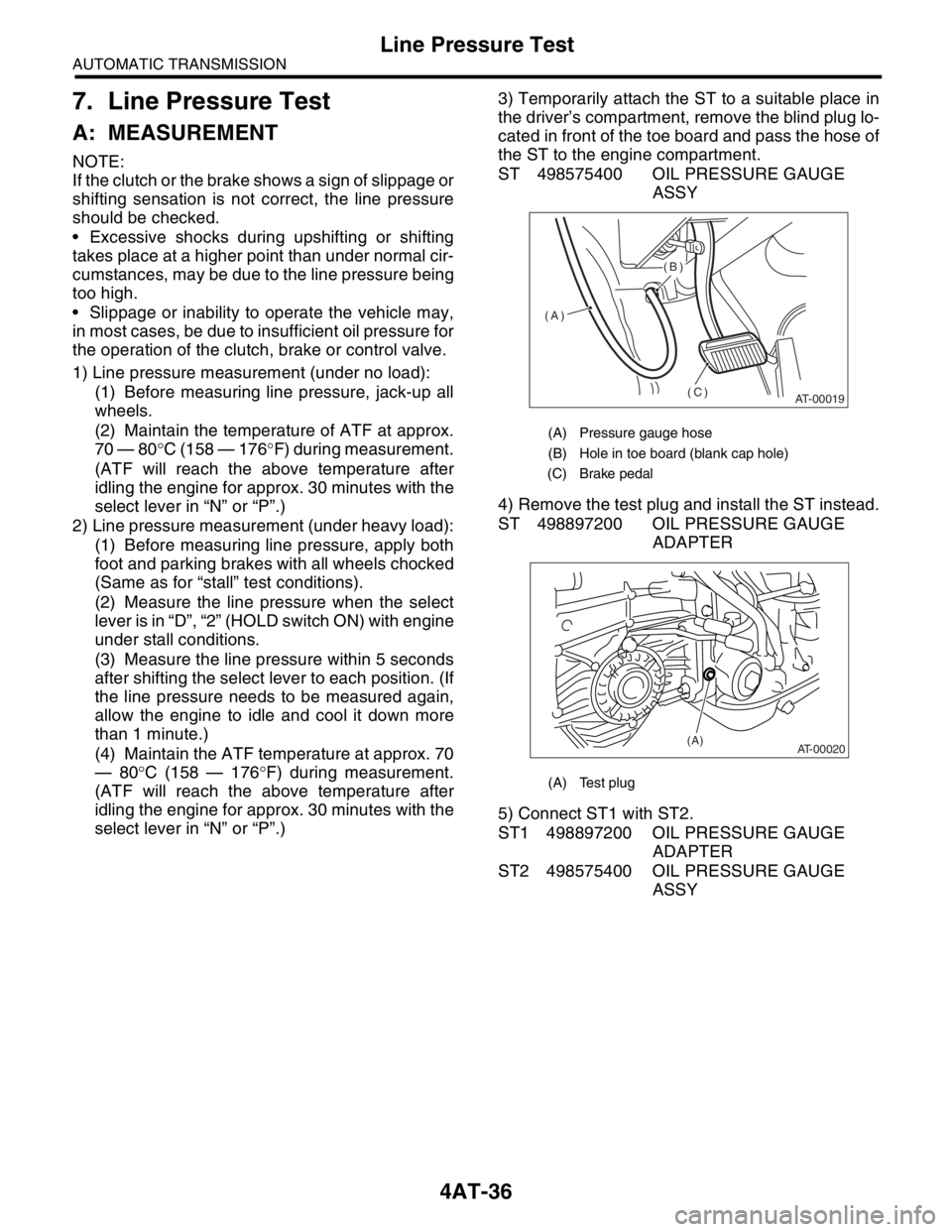2004 SUBARU FORESTER parking brake
[x] Cancel search: parking brakePage 2344 of 2870

4AT-32
AUTOMATIC TRANSMISSION
Road Test
4. Road Test
A: INSPECTION
1. GENERAL PRECAUTION
Road tests should be conducted to properly diag-
nose the condition of the automatic transmission.
NOTE:
When performing the test, do not exceed posted
speed limit.
2. D RANGE SHIFT FUNCTION
Check shifting between 1st ←→ 2nd ←→ 3rd ←→
4th while driving on normal city streets.
3. D RANGE SHIFT SHOCK
Check the shock level when shifting up during nor-
mal driving.
4. KICK-DOWN FUNCTION
Check kick-down for each gear. Also check the
kick-down shock level.
5. ENGINE BRAKE OPERATION
Check the 3rd gear engine brake when shifting
down from D ←→ 3rd range while driving in 4th
gear of D range [50 — 60 km/h (31 — 37 MPH)].
Check the 2nd gear engine brake when shifting
between 3rd ←→ 2nd range while driving in the 3rd
range of 3rd gear [40 — 50 km/h (25 — 31 MPH)].
Check the 1st gear engine brake when shifting
between 2nd ←→ 1st range while driving in the 2nd
range of 2nd gear [20 — 30 km/h (12 — 19 MPH)].
6. LOCK-UP FUNCTION
Check that rpm does not change sharply when
the axle pedal is lightly depressed when driving on
flat roads at 60 km/h (37 MPH).
Check slip lock-up with following procedure.
Subaru Select Monitor is needed for checking (EC,
EK model).
Before start checking, check that the DTC is not ex-
isted using Subaru Select Monitor. When the DTC
is existed, perform the collective action with DTC
and check that the DTC is not existed again, and
then start the checking.
1) The check performed on flat and straight road or
free roller.
NOTE:
Slip lock-up does not operate when the vehicle is
lifted up, because of not occurring surface resis-
tance.
Also checking on the free roller, check with de-
pressing foot brake lightly to make the checking
easier, because the surface resistance will be defi-
cient2) Connect the Subaru Select Monitor.
3) Check ATF temperature using Subaru Select
Monitor.
NOTE:
ATF temperature is between 50 — 100°C (122
— 212°F).
When the temperature is low, warm-up the ATF
by running the vehicle or etc.
4) Start the engine, and make the lock-up duty be
able to read on data display of Subaru Select Mon-
itor.
5) 35 — 40 Drive the vehicle at a constant speed of
35 — 40 km/h (22 — 25 MPH).
6) Read the lock-up duty while vehicle is running.
Standard value:
25 — 45%
NOTE:
On the free roller, the value sometimes lowers.
Slip lock-up control is not operating when the
lock-up duty is less than 5%, or when the lock-up
duty goes down immediately after starts rise. On
these cases, improper ATF or deterioration of ATF
may be the cause. Check the amount of ATF or re-
place them, and then recheck it.
7. P RANGE OPERATION
Stop the vehicle on an uphill grade of 5% or more
and shift to “P” range. Check that the vehicle does
not move when the parking brake is released.
8. NOISE AND VIBRATION
Check for unusual sounds and vibration while driv-
ing and during shifting.
9. CLIMBING CONTROL FUNCTION
Check that the gear remains in 3rd when going
up a grade.
Check that the gear remains in 3rd when apply-
ing the brakes while going down a grade.
10.TRANSFER CLUTCH
Check tight corner braking when the vehicle started
with steering fully turned.
11.OIL LEAKS
After the driving test, inspect for oil leaks.
Page 2345 of 2870

4AT-33
AUTOMATIC TRANSMISSION
Stall Test
5. Stall Test
A: INSPECTION
NOTE:
The stall test is of extreme importance in diagnos-
ing the condition of the automatic transmission and
the engine. It should be conducted to measure the
engine stall speeds in “R” and “2” ranges (when
HOLD switch is ON).
Purposes of the stall test:
To check the operation of the automatic trans-
mission clutch.
To check the operation of the torque converter
clutch.
To check engine performance.
1) Check that the throttle valve opens fully.
2) Check that the engine oil level is correct.
3) Check that the coolant level is correct.
4) Check that the ATF level is correct.
5) Check that the differential gear oil level is cor-
rect.
6) Increase ATF temperature to 70 — 80°C (158 —
176°F) by idling the engine for approximately 30
minutes (with select lever set to “N” or “P”).
7) Place the wheel chocks at the front and rear of
all wheels and engage the parking brake.
8) Shift the manual linkage to ensure it operates
properly, then shift the select lever to the “2” range
and turn the HOLD switch to ON.
9) While forcibly depressing the foot brake pedal,
gradually depress the accelerator pedal until the
engine operates at full throttle.
10) When the engine speed is stabilized, record
that speed quickly and release the accelerator ped-
al.
11) Shift the select lever to “N” range, and cool
down the engine by idling it for more than one
minute.12) If the stall speed in “2” range (with HOLD switch
ON) is higher than specifications, low clutch slip-
ping and “2-4 brake slipping” may occur. To identify
it, conduct the same test as above in “R” range.
13) Perform the stall tests with the select lever in
the “D” range.
NOTE:
Do not continue the stall test for more than five
seconds at a time (from closed throttle, fully open
throttle to stall speed reading). Failure to follow this
instruction causes the engine oil and ATF to deteri-
orate and the clutch and brake to be adversely af-
fected.
Be sure to cool down the engine for at least one
minute after each stall test with the select lever set
in the “P” or “N” range and with the idle speed lower
than 1,200 rpm.
If the stall speed is higher than the specified
range, attempt to finish the stall test in as short a
time as possible, in order to prevent the automatic
transmission from sustaining damage.
Stall speed (at sea level):
2.0 L NON-TURBO MODEL
2,000 — 2,500 rpm
2.0 L TURBO MODEL
2,600 — 3,300 rpm
2.5 L NON-TURBO MODEL
2,100 — 2,600 rpm
2.5 L TURBO MODEL
2,700 — 3,200 rpm
(A) Brake pedal
(B) Accelerator pedal
(A) (B)
P
R
N
D
3
2
1
AT-00449
Page 2347 of 2870

4AT-35
AUTOMATIC TRANSMISSION
Time Lag Test
6. Time Lag Test
A: INSPECTION
NOTE:
If the select lever is shifted while the engine is
idling, there will be a certain time elapse or lag be-
fore the shock can be felt. This is used for checking
the condition of the low clutch, reverse clutch, low &
reverse brake and one-way clutch.
Perform the test at normal operation fluid tem-
perature 70 — 80°C (158 — 176°F).
Be sure to allow a one minute interval between
tests.
Perform measurement for three times and take
the average value.
1) Fully apply the parking brake.
2) Start the engine.
Check the idling speed (A/C OFF).
3) Shift the select lever from “N” to “D” range.
Using a stop watch, measure the time it takes from
shifting the lever until the shock is felt.
Time lag: Less than 1.2 seconds
If “N” → “D” time lag is longer than specified:
Line pressure too low
Low clutch worn
One-way clutch not operating properly
D-ring worn
4) In the same manner, measure the time lag for
“N” → “R”.
Time lag: Less than 1.5 seconds
If “N” → “R” time lag is longer than specified:
Line pressure too low
Reverse clutch worn
Low & reverse brake worn
D-ring worn
Page 2348 of 2870

4AT-36
AUTOMATIC TRANSMISSION
Line Pressure Test
7. Line Pressure Test
A: MEASUREMENT
NOTE:
If the clutch or the brake shows a sign of slippage or
shifting sensation is not correct, the line pressure
should be checked.
Excessive shocks during upshifting or shifting
takes place at a higher point than under normal cir-
cumstances, may be due to the line pressure being
too high.
Slippage or inability to operate the vehicle may,
in most cases, be due to insufficient oil pressure for
the operation of the clutch, brake or control valve.
1) Line pressure measurement (under no load):
(1) Before measuring line pressure, jack-up all
wheels.
(2) Maintain the temperature of ATF at approx.
70 — 80°C (158 — 176°F) during measurement.
(ATF will reach the above temperature after
idling the engine for approx. 30 minutes with the
select lever in “N” or “P”.)
2) Line pressure measurement (under heavy load):
(1) Before measuring line pressure, apply both
foot and parking brakes with all wheels chocked
(Same as for “stall” test conditions).
(2) Measure the line pressure when the select
lever is in “D”, “2” (HOLD switch ON) with engine
under stall conditions.
(3) Measure the line pressure within 5 seconds
after shifting the select lever to each position. (If
the line pressure needs to be measured again,
allow the engine to idle and cool it down more
than 1 minute.)
(4) Maintain the ATF temperature at approx. 70
— 80°C (158 — 176°F) during measurement.
(ATF will reach the above temperature after
idling the engine for approx. 30 minutes with the
select lever in “N” or “P”.)3) Temporarily attach the ST to a suitable place in
the driver’s compartment, remove the blind plug lo-
cated in front of the toe board and pass the hose of
the ST to the engine compartment.
ST 498575400 OIL PRESSURE GAUGE
ASSY
4) Remove the test plug and install the ST instead.
ST 498897200 OIL PRESSURE GAUGE
ADAPTER
5) Connect ST1 with ST2.
ST1 498897200 OIL PRESSURE GAUGE
ADAPTER
ST2 498575400 OIL PRESSURE GAUGE
ASSY
(A) Pressure gauge hose
(B) Hole in toe board (blank cap hole)
(C) Brake pedal
(A) Test plug
AT-00019
(A)(B)
(C)
AT-00020(A)
Page 2383 of 2870

4AT-70
AUTOMATIC TRANSMISSION
Air Bleeding of Control Valve
18.Air Bleeding of Control Valve
A: PROCEDURE
1) Lift-up the vehicle with shifting the select lever to
“P” range and applying the parking brake.
2) Connect the Subaru Select Monitor to the vehi-
cle.
3) Make sure there is no trouble code using Subaru
Select Monitor.
4) Using Subaru Select Monitor, check that the
ATF temperature is in less than 60°C (140°F).
5) Power OFF the Subaru Select Monitor.
6) Turn the ignition switch to “OFF”.
7) Shift the select lever to “R” range.
8) Depress the brake pedal fully until the air bleed-
ing is completed.
9) Turn the ignition switch to ON.
10) Shift the select lever to “P” range, and then wait
for more than 3 seconds.
11) Shift the select lever to “R” range, and then wait
for more than 3 seconds.
12) Shift the select lever to “N” range, and then wait
for more than 3 seconds.
13) Shift the select lever to “D” range, and then wait
for more than 3 seconds.
14) Shift the select lever to “N” range, and then wait
for more than 3 seconds.
15) Slightly depress the accelerator pedal fully.
16) Slightly release the accelerator pedal fully.
17) Start the engine.
18) Shift the select lever to “D” range.
19) Turn the Subaru Select Monitor switch to ON.
20) Select {Each System Check} in «Main Menu»
of Subaru Select Monitor.
21) On the «System Selection Menu» display
screen, select the “Transmission”. Air bleeding of
control valve starts on transmission. At this time,
the POWER indicator light in combination meter
blinks at 2 Hz. When the POWER indicator light
does not blink, repeat the procedures from step 4).
22) Air bleeding of control valve is finished when
blinking of POWER indicator light in combination
meter changes from 2 Hz to 0.5 Hz.
NOTE:
When blinking of POWER indicator light changes
from 2 Hz to 4 Hz during air bleeding, repeat the
procedure from step 4).
23) Shift the select lever to “N” range, and then turn
the ignition switch to OFF.
24) Shift the select lever to the “P” range, and then
finish the air bleeding.
Page 2477 of 2870
![SUBARU FORESTER 2004 Service Repair Manual 4AT(H4SO)-18
AUTOMATIC TRANSMISSION (DIAGNOSTIC)
Subaru Select Monitor
2. READ CURRENT DATA
1) On the «Main Menu» display screen, select the {Each System Check} and press the [YES] key.
2) On the « SUBARU FORESTER 2004 Service Repair Manual 4AT(H4SO)-18
AUTOMATIC TRANSMISSION (DIAGNOSTIC)
Subaru Select Monitor
2. READ CURRENT DATA
1) On the «Main Menu» display screen, select the {Each System Check} and press the [YES] key.
2) On the «](/manual-img/17/57426/w960_57426-2476.png)
4AT(H4SO)-18
AUTOMATIC TRANSMISSION (DIAGNOSTIC)
Subaru Select Monitor
2. READ CURRENT DATA
1) On the «Main Menu» display screen, select the {Each System Check} and press the [YES] key.
2) On the «System Selection Menu» display screen, select the {Transmission Control System} and press the
[YES] key.
3) Press the [YES] key after the information of transmission type is displayed.
4) On the «Transmission Diagnosis» display screen, select the {Current Data Display & Save} and press the
[YES] key.
5) On the «Data Display Menu» display screen, select the {Data Display} and press the [YES] key.
6) Using the scroll key, move the display screen up or down until desired data is shown.
A list of the support data is shown in the following table.
NOTE:
For detailed operation procedure, refer to the SUBARU SELECT MONITOR OPERATION MANUAL.
Contents Display Unit of measure
Battery voltage Battery Voltage V
Rear vehicle speed sensor signal Rear Wheel Speed km/h or MPH
Front vehicle speed sensor signal Front Wheel Speed km/h or MPH
Engine speed signal Engine Speed rpm
Automatic transmission fluid temperature signal ATF Temp.°C or °F
Throttle position signal Throttle Sensor Voltage V
Gear position Gear Position —
Line pressure control duty ratio Line Pressure Duty Ratio %
Lock up clutch control duty ratio Lock Up Duty Ratio %
Transfer clutch control duty ratio (AWD model) Transfer Duty Ratio %
Power supply for throttle position sensor Throttle Sensor Power V
Torque converter turbine speed signal Turbine Revolution Speed rpm
2-4 brake timing pressure control duty ratio Brake Clutch Duty Ratio %
Intake manifold pressure sensor voltage Mani. Pressure Voltage V
FWD switch signal FWD Switch ON or OFF
Stop light switch signal Stop Light Switch ON or OFF
Anti lock brake system signal ABS Signal ON or OFF
Cruise control system signal Cruise Control Signal ON or OFF
Parking range signal P Range Signal ON or OFF
Neutral range signal N Range Signal ON or OFF
Reverse range signal R Range Signal ON or OFF
Drive range signal D Range Signal ON or OFF
3rd range signal 3rd Range Signal ON or OFF
2nd range signal 2nd Range Signal ON or OFF
1st range signal 1st Range Signal ON or OFF
Shift control solenoid A Shift Solenoid #1 ON or OFF
Shift control solenoid B Shift Solenoid #2 ON or OFF
Torque control output signal #1 Torque Control Signal 1 ON or OFF
Torque control output signal #2 Torque Control Signal 2 ON or OFF
Torque control cut signal Torque Control Cut Sig. ON or OFF
2-4 brake timing control solenoid valve 2-4 Brake Timing Sol. ON or OFF
Low clutch timing control solenoid valve Low Clutch Timing Sol. ON or OFF
Automatic transmission diagnosis indicator lamp Diagnosis Lamp ON or OFF
Power mode switch signal Power Mode Switch ON or OFF
Hold mode switch signal Hold Mode Switch ON or OFF
Kick down switch signal Kick Down Switch ON or OFF
Automatic transmission fluid temperature lamp ATF Temperature Lamp ON or OFF
Page 2569 of 2870

4AT(H4SO)-110
AUTOMATIC TRANSMISSION (DIAGNOSTIC)
Symptom Related Diagnostic
15.Symptom Related Diagnostic
A: INSPECTION
Symptom Problem parts
Starter does not rotate when select lever is in “P” or “N” range;
starter rotates when select lever is in “R”, “D”, “3” or “2” range. Inhibitor switch
Select cable
Select lever
Starter motor and harness
Abnormal noise when select lever is in “P” or “N” range. Strainer
Transfer duty solenoid
Oil pump
Drive plate
ATF level too high or too low
Hissing noise occurs during standing start. Strainer
ATF level too high or too low
Noise occurs while driving in “D1”. Final gear
Planetary gear
Reduction gear
Differential gear oil level too high or too low Noise occurs while driving in “D2”.
Noise occurs while driving in “D3”. Final gear
Low & reverse brake
Reduction gear
Differential gear oil level too high or too low
Noise occurs while driving in “D4”. Final gear
Low & reverse brake
Planetary gear
Reduction gear
Differential gear oil level too high or too low
Engine stalls while shifting from “1” range to another. Control valve
Lock-up damper
Engine performance
Input shaft
Vehicle moves when select lever is in “N” range. Low clutch
Shock occurs when select lever is moved from “N” to “D” range.TCM
Harness
Control valve
ATF deterioration
Excessive time lag occurs when select lever is moved from “N”
to “D” range. Control valve
Low clutch
Line pressure duty solenoid
Seal ring
Front gasket transmission case
Shock occurs when select lever is moved from “N” to “R” range.TCM
Harness
Control valve
ATF deterioration
Excessive time lag occurs when select lever is moved from “N”
to “R” range. Control valve
Low & reverse clutch
Reverse clutch
Line pressure duty solenoid
Seal ring
Front gasket transmission case
Vehicle does not start in any shift range (engine stalls). Parking brake mechanism
Planetary gear
Page 2570 of 2870

4AT(H4SO)-111
AUTOMATIC TRANSMISSION (DIAGNOSTIC)
Symptom Related Diagnostic
Vehicle does not start in any shift range (engine revving up). Strainer
Line pressure duty solenoid
Control valve
Drive pinion
Hypoid gear
Axle shaft
Differential gear
Oil pump
Input shaft
Output shaft
Planetary gear
Drive plate
ATF level too low
Front gasket transmission case
Vehicle does not start in “R” range only (engine revving up). Select cable
Select lever
Control valve
Low & reverse clutch
Reverse clutch
Vehicle does not start in “R” range only (engine stalls). Low clutch
2-4 brake
Planetary gear
Parking brake mechanism
Vehicle does not start in “D”, “3” range only (engine revving up). Low clutch
One-way clutch
Vehicle does not start in “D”, “3” or “2” range only (engine rev-
ving up). Low clutch
Vehicle does not start in “D”, “3” or “2” range only (engine stalls). Reverse clutch
Vehicle starts in “R” range only (engine revving up). Control valve
Acceleration during standing starts is poor (high stall rpm). Control valve
Low clutch
Reverse clutch
ATF level too low
Front gasket transmission case
Differential gear oil level too high or too low
Acceleration during standing starts is poor (low stall rpm). Oil pump
Torque converter one-way clutch
Engine performance
Acceleration is poor when select lever is in “D”, “3” or “2” range
(normal stall rpm).TCM
Control valve
High clutch
2-4 brake
Planetary gear
Acceleration is poor when select lever is in “R” (normal stall rpm). Control valve
High clutch
2-4 brake
Planetary gear
No shift occurs from 1st to 2nd gear.TCM
Rear vehicle speed sensor
Front vehicle speed sensor
Throttle position sensor
Shift solenoid 1
Control valve
2-4 brake
No shift occurs from 2nd to 3rd gear.TCM
Control valve
High clutch
Shift solenoid 2 Symptom Problem parts